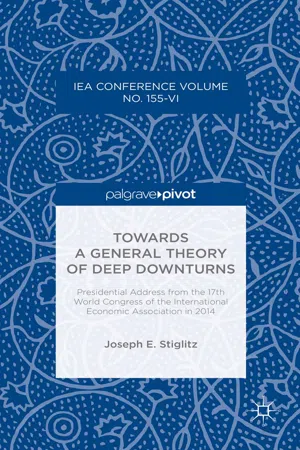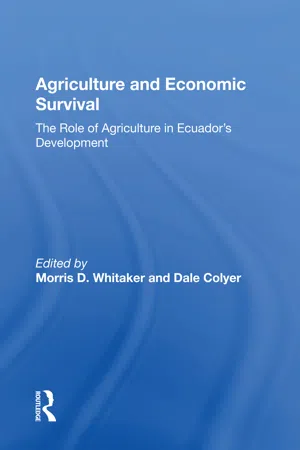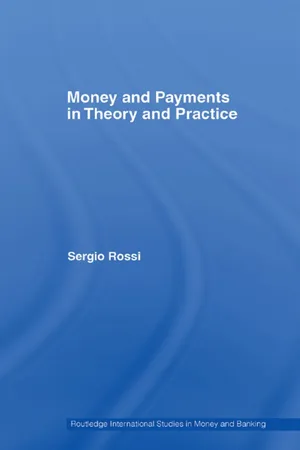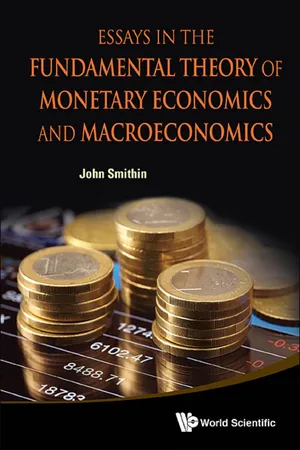Economics
Credit
Credit refers to the ability to borrow money or access goods or services with the promise of future payment. In economics, credit plays a crucial role in facilitating consumption and investment, as it allows individuals and businesses to make purchases or investments beyond their current financial means. It also contributes to the overall liquidity and functioning of the economy.
Written by Perlego with AI-assistance
4 Key excerpts on "Credit"
- eBook - ePub
Towards a General Theory of Deep Downturns
Presidential Address from the 17th World Congress of the International Economic Association in 2014
- Joseph E. Stiglitz(Author)
- 2016(Publication Date)
- Palgrave Macmillan(Publisher)
What enables individuals to spend more than the resources available (for either consumption or investment) is access to Credit. Credit is different from ordinary commodities. In particular, Credit can be created out of thin air. If the bank gives me a piece of paper which others accept, I can buy goods with it, increasing aggregate demand. The bank can create these pieces of paper almost at will. (There are limits, which I shall discuss shortly.) But this is markedly different from the seed economy discussed earlier: the bank then could only lend out seeds if someone else had deposited the seeds – in effect, had lent the seeds to the bank. Macroeconomic consequences of changes in Credit availability With aggregate demand depending on Credit availability, changes in Credit availability can have macroeconomic consequences. For reasons that we have already explained, adjustments in prices do not instantaneously offset these increases in Credit. Moreover, there is no presumption that the market supply of Credit will ensure aggregate demand equaling aggregate supply. A key function of monetary policy is to provide the requisite coordination: to ensure that the aggregate demand for goods equals the aggregate supply. In the seed economy, there was no need for this – the interest rate adjusted to make sure that the demand for seed equaled the supply. Trust as the basis of Credit This poses the central question: what limits the banks’ provision of Credit; and what would limit it in the absence of constraints imposed by monetary authorities? A Credit economy is based on trust, and in particular, trust that the money that is borrowed will be repaid; and trust that the money that is received will be honored by others. If a financial institution is trusted, it can create “money” (“Credit”) on its own, issuing IOU’s that will be honored by others - eBook - ePub
Agriculture And Economic Survival
The Role Of Agriculture In Ecuador's Development
- Morris D Whitaker(Author)
- 2021(Publication Date)
- Routledge(Publisher)
9
Credit AND Credit POLICIES
Hugo Ramos and Lindon RobisonDOI: 10.4324/9780429046056-9This chapter analyzes agricultural Credit and Credit policies. The goal is to explain how these have influenced the development of Ecuador’s agricultural sector. Since agricultural Credit and Credit policy are the major themes, they are first defined. Credit is the ability to borrow. Thus Credit is a reserve or a resource that can be exchanged for loans or maintained as a reserve to be used when needed. The amount of Credit available to an individual borrower depends on lenders having funds to lend and borrowers having demonstrated they are trustworthy. Loans then are not Credit but what is exchanged for Credit.Credit is important in agricultural development because all investments in agriculture require an initial commitment of funds in return for expected future profits. As a result, there will be a lapse between the time funds are committed to the investment and when the investment generates the income necessary to repay the costs of the investment. Few firms have the liquid funds (cash and legal instruments easily converted to cash) necessary to pay for investments initially and therefore will need Credit to invest. Unless there is a well-functioning Credit system that provides loan funds on a timely basis and at a reasonable cost, investments and resulting increased productivity will be reduced and economic development retarded.Ecuador’s agricultural Credit policy consists of the private and public terms and conditions under which savers save and borrowers borrow and how these terms are enforced in the agricultural sector. These policies are important in agricultural development because they influence the access to and cost of loan funds. Tim, in turn, helps determine which firms will make the investments required to produce, process and distribute agricultural products. Those firms with adequate access to Credit will have significant advantages over firms without such access. Thus, the organization of the agricultural sector will be influenced by agricultural Credit policies. Agricultural Credit policies also affect consumers because the organization of production helps to determine the price and availability of food products. - eBook - ePub
- Sergio Rossi(Author)
- 2007(Publication Date)
- Routledge(Publisher)
ex nihilo. The Credit that a bank may grant to a firm is therefore related substantially to production. It is production that makes it possible for income to exist and to be lent to banks’ borrowers. Yet, without banks, no income would be produced, as no Credit would be available for firms to pay out the relevant amount of wages. To explain Credit, it is therefore necessary to explain both the emission of money and the financial intermediation carried out by banks in any payment they issue, starting logically with the payment of production costs, which is an income-generating operation, as we shall better understand in the next chapter.Before moving on, however, there remains an issue to be discussed in this chapter. In fact, according to traditional analysis, the Credit supply is and can be controlled by the central bank, which affects the money stock, M, via the base money multiplier, m, as epitomized by the textbook formula M = mB, where B represents the monetary base (labelled high-powered money) supplied by the central bank. Banks would therefore be able to grant Credit to the extent that they have enough reserves of liquidity, in the form of high-powered money (as in fractional reserve banking). The supply of Credit would thus depend on the supply of money, which would itself depend on central bank policy. We will consider this issue as a gambit to Chapter 2.Money and Credit supply
Generally speaking, the textbook story admits that banks create money – in the form of deposits, D – as a multiple of central bank money. This story, however, sets off from the traditional hypothesis that the monetary base is an exogenous variable, like the reserve-to-deposit ratio R/D, and the currency-to-deposit ratio C/D, both ratios entering the determination of m - John Smithin(Author)
- 2013(Publication Date)
- WSPC(Publisher)
Credit ! (original emphasis)Meanwhile, Geoffrey Ingham, in his influential book, the Nature of Money (2004, p. 198), explicitly states that “all money is debt ... ”, and at the same time refers throughout the work to the system of “capitalist Credit money”.These positions are obviously far more realistic, both in terms of the historical development of a distinctive system of capitalism, and in thinking about current affairs, than the idea that the origins of money lie merely in the offer of one or another physical item in exchange for some other physical thing. Adam Smith (1981/1776, p. 65) talked about “an early and rude state of society” in which he imagined this sort of thing taking place, but as Searle (2010, p. 62) has astutely remarked “there is no such thing as a state of nature ” (emphasis added) as far as human social institutions, including commerce, are concerned.However, once we do start talking about social accounting and thereby use terms like “Credit money” and “debt money”, there is one obvious pitfall that needs to be pointed out and dealt with straight-away. This is simply that in any banking or financial system, Credit and debt are just the mirror images of each other. For every debt there is a Credit and vice versa. If, for example, a commercial bank extends a loan to an individual or a firm, then that would correctly be described as the granting of Credit, and the loan is an earning asset to the bank. On the other hand, if somebody makes a deposit in a bank then, from the bank’s point of view, that is a debt or liability. Confusion arises because, by definition, assets must be equal to liabilities in a balance sheet. Therefore, when a bank or similar financial institution does extends Credit, its asset portfolio increases, but at the same time the liabilities side of the balance sheet must necessarily be rising also. In the simplest case, the person or firm receiving the loan just deposits the funds back with the same bank. Moreover, even if all of the funds are paid away to another financial institution the assets and liabilities of the system as a whole rise to exactly the same extent. So, there is always both Credit creation and money creation at the same time. Conversely, when the loans are paid back this must amount to the “destruction” of money and Credit. We need to be clear, therefore, in discussing these balance sheet operations, about which side of the balance sheet contains the entries we actually think of as money. The correct answer is that it is the funds (deposits) on the liabilities
Index pages curate the most relevant extracts from our library of academic textbooks. They’ve been created using an in-house natural language model (NLM), each adding context and meaning to key research topics.
Explore more topic indexes
Explore more topic indexes
1 of 6
Explore more topic indexes
1 of 4



